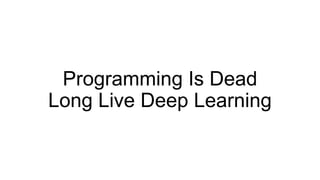Programming Is Dead, Long Live Deep Learning
- 1. Programming Is Dead Long Live Deep Learning
- 2. ŌĆ£ProgrammingŌĆØ A Peanut Butter Jelly Sandwich
- 3. Student gives professor instructions on how to make a PB&J Sandwich Step 1: Put the peanut butter on the bread.
- 4. Whoops! New Step 1: Open the top of peanut butter by twisting counter clockwiseŌĆ”
- 5. Good Programming Bad Programming In traditional programming, the computer isnŌĆÖt responsible for the outcome. It just does what a human told it to do.
- 6. ŌĆ£Deep LearningŌĆØ Approach to the PB&J
- 7. Good Sandwich Bad Sandwich Deep Learning Starts From The End. You label the outcomes. And you give it A LOT of data.
- 8. 1st Type of Deep Learning: Understanding What It Sees (what Google Photos does) NEW IMAGE LOOKS AT BILLIONS OF DETAILS FROM TRAINING DATA (NOT HUMAN READABLE) DECIDES: NO TOP BREAD WHEAT BREAD JELLY > PEANUT BUTTER CRUST NOT REMOVED
- 9. Try peanut butter and jelly on same side 2nd Type Of Deep Learning: Trying To Achieve A Goal (what AlphaGo does) TryŌĆ” from the edge, from the center, wheat bread, white bread, chunky peanut butter, and millions of other ideas Try peanut butter on one side, jelly on other
- 10. The real magic is not this at the end (although delicious it might be): The magic is that even if you give it unexpected inputsŌĆ”
- 11. It can still make this and this and thisŌĆ” And no human had to tell it what to do.
- 12. Pre Deep Learning Programs Given Instructions Post Deep Learning Programs Given Outcomes
- 13. You want products to do what YOU expect. Cars that donŌĆÖt kill people Medical devices that donŌĆÖt miss a disease Educational software that adapts to the child Kitchen appliances that cook food thoroughly
- 14. Leonard Speiser Neuron VC https://angel.co/neuron-vc leonard at speiser dot net https://www.linkedin.com/in/leonardspeiser
Editor's Notes
- #4: Professor has all the materials of a sandwich on the table, and follows the instructions of the students to the letter.














